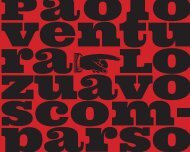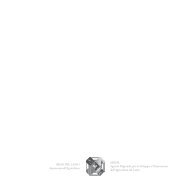Giuseppe Cavalli
Giuseppe Cavalli
Giuseppe Cavalli
- No tags were found...
You also want an ePaper? Increase the reach of your titles
YUMPU automatically turns print PDFs into web optimized ePapers that Google loves.
Photography<br />
as an artistic means<br />
Anita<br />
Margiotta<br />
<strong>Giuseppe</strong> <strong>Cavalli</strong> was active as a photographer for more than twenty-five years: from the mid-Thirties, when he<br />
bought his first Leica, to his sudden premature death in 1961. These were crucial years in Italian history and art,<br />
spanning the tragic period preceding the outbreak of the Second World War and the difficult postwar reconstruction<br />
period, and ending at the threshold of the legendary 1960s and the economic boom that marked Italy’s definitive<br />
exit from the world of agricultural economies and launched it among the world powers. Economic and energy<br />
crises were still a long way off, and it was a period in which poverty and moral and material problems alternated with<br />
hope and faith in the future.<br />
Thus, <strong>Cavalli</strong> embarked on his photographic career at the height of the Fascist period, when all photographic<br />
production hinged on the debate concerning the relationship between artistic photography and reportage, that is<br />
between formalists and realists – a highly relevant issue at the time – although, on closer examination, the dividing<br />
line between the two genres was not always that clear-cut.<br />
At a time when new topics were being discussed in the field of art and photography in the United States,<br />
Germany and the Soviet Union, the advent of Fascism in Italy slowed down the autonomous development of<br />
visual language, sundering the relationship between photography and culture, between art and photography.<br />
Although many individuals engaged in isolated experiments, it was not until after the war that photographers and<br />
intellectuals re-established close contact. Moreover, during that period the relationship between intellectuals and the<br />
Italian political world was very strained, if not actually nonexistent. Only a few lone voices continued, where possible,<br />
to speak out individually, thus keeping alive the cultural humus that would form the foundations for renewed<br />
artistic experiences in better times.<br />
Yet Fascism understood that photography was an important tool of communication and persuasion, equal to<br />
radio and cinema. That is why the regime favoured certain aspects of reportage and photojournalism while seeking<br />
to purge them of any critical content. During the long Fascist years, until the Second World War in fact, they were<br />
used for ideological and political ends, and it was not until the end of the war that long-repressed social issues<br />
emerged and were treated by Neorealism.<br />
The only public commission that <strong>Giuseppe</strong> <strong>Cavalli</strong> accepted, came from the Director General for Antiquities and<br />
Fine Arts, Ranuccio Bianchi Bandinelli, who through the Florence Superintendency, assigned to him the task of<br />
reproducing the panels of Lorenzo Ghiberti’s Gates of Paradise for the Baptistery. This is indicative of photography’s<br />
role in Italy in the first half of the twentieth century, when it was not an art but purely a means of documentation,<br />
but one that imposed a well-defined vision inherent in its language.<br />
Although <strong>Cavalli</strong> always drew his inspiration from places that were familiar and dear to him or from the social<br />
context in which he lived, his artistic production went beyond the private sphere to achieve a broader, more extensive<br />
reach.<br />
He had much contact with both live and abstract contemporary European and American photographic experiences,<br />
which a cultured and informed man like himself was certainly well up on. This characteristic of his has been<br />
widely acknowledged; in fact, he was among the artists chosen as best representing Italy’s development during the<br />
postwar period for the exhibition entitled Italian Metamorphosis 1943-1968 held at the Guggenheim, New York, in<br />
1995.<br />
As well as the relationship between <strong>Cavalli</strong>’s artistic themes and contemporary national and foreign experiences,<br />
it should be mentioned that a strong sense of local and family traditions led him to exalt poetic and literary values<br />
with a strong humanist slant in his work. These pervade the subjects he represents, since as he himself said: “great<br />
artists are not at all concerned with expressing the feeling of the subject, but rather their own feeling.”<br />
<strong>Cavalli</strong> believed that photography had to break from the preconception of its merely being an imitation of reality,<br />
and once again become the sister of painting – as it was conceived by Daguerre when it was invented in 1839 –<br />
which is how many nineteenth-century photographers saw it. He stated in the Manifesto of the photographic group<br />
La Bussola, composed of Vincenzo Balocchi, Mario Finazzi, Ferruccio Leiss, Federico Vender, Luigi Veronesi and<br />
<strong>Cavalli</strong> himself and founded in 1947, that their aim was to make photography an art, that it was possible to be an<br />
artist with a camera in the same way that one could be an artist with a brush, a sculptor with a chisel, or a poet with<br />
a pen. Like all artists, in fact, the photographer sees things that others do not see, or look at inattentively; the sub-<br />
180







